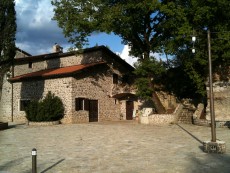Casale Anio novus
municipality: TIVOLI
Province: Roma
Typology:
Available for:
weddings, parties, advertising sets, films, fashion shows, meetings, etc.

route aqueduct anio novus Captava the waters in the upper valley of the Aniene, hence the name, to which was added the adjective "novus" to distinguish it from the other aqueduct Anio, of about three centuries older, which since then was called "vetus". The water was taken directly from the river, about 6 km upstream of the Aqua Claudia springs, near the municipality of Subiaco, at the XLII mile of the Via Sublacensis. Near the Claudia springs (but on the other side of the river) it received the waters from the "Rivus Herculaneus", which, provided with purer water, increased it and improved it. The banks of the Aniene were in fact subject to landslides that, above all in occasion of abundant precipitations, clouded the water to the point that not even the "swimming pool limaria" (the basin of decantation for the "cleaning" of the water) built near Agosta was able to clean it satisfactorily. Immersed immediately in the conduit, the water often arrived in Rome still turbid. It cannot be ruled out that this was precisely the reason why Nerone had the three artificial lakes originated from as many dams along the river and connected by a system of sluices in his villa near Subiaco. The three lakes, in fact, positioned at different levels, constituted a sort of large swimming pool in which the water, in the transfer from a small lake to another, lost a good part of the residual impurities. In 98 Trajan moved the origin of the aqueduct, starting it directly from the second of the three lakes, about where today the monastery of San Benedetto is located. Parco degli Acquedotti: the archways of support for the double duct of the Claudian Aqueduct (lower channel) and of the Anio novus (upper canal) The Anio novus had the greatest route of all the other aqueducts of the time: 58.700 Roman miles [ 1], equal to 86.876 km, of which about 73 km underground and about 14 on the surface; half of the superficial path was shared with the Aqua Claudia, to whose channel the Anio novus overlapped from the 7th mile of the Via Latina to reach Rome on the arches still largely visible in the Aqueduct Park. Following the Aniene valley on the left of the river, about halfway between Subiaco and Mandela, it was flanked, at a higher level, first by the Aqua Claudia conduit, then by the Acqua Marcia conduit and later, after Mandela, to that of the Anio vetus. After Castel Madama she left the river momentarily to get closer again after going around a couple of hills. Leaving a secondary branch, it continued towards Tivoli on viaducts and bridges of which important and imposing remains remain, it bent to the south and therefore circumvented the Tiburtini mountains from the west, crossing then a large cistern (dating back to the Severi era) inside the which joined again with the secondary branch left before Tivoli. The cistern consisted of three communicating rooms and, in addition to acting as a swimming pool, had the important task of integrating, if necessary, the conduits of the Anio vetus, the Acqua Marcia and the Aqua Claudia that ran at one level lower. After passing Gallicano in an underground conduit, it came out again on the surface and, again on bridges and viaducts still visible, it joined the Via Prenestina, then reached Via Latina and then Capannelle, where there was another swimming pool after which the conduit he leaned on that of the Aqua Claudia with which he ran together until he entered Rome in the place called ad spem veterem, near Porta Maggiore. The daily flow rate, the largest of all, was 4,738 quinarie [2], equal to 196,627 m3 and 2,274 liters per second. Just before Porta Maggiore, 163 quinarie were sold, with a special conduit, to the Aqua Tepula aqueduct. Like the Aqua Claudia, this aqueduct was begun by Caligula in AD 38 and completed by Claudius in 52. From the seventh milestone outside the city, it was carried out on the arches of the Aqua Claudia. It provided more water (190,000 cubic meters per day) than any other aqueduct. The Roman aqueducts were a gravity-based system: the higher the altitude of the source of the water, the greater the water pressure. Because of its height, it has enough pressure to deliver water to even the highest spots in the city. Anio Novus From Samuel Ball Platner, A Topographical Dictionary of Ancient Rome, rev. Thomas Ashby. Oxford: 1929, p. 11-12. An aqueduct, which, like the aqua Claudia, was begun by Caligula in 38 AD (Suet. Cal. 20) and completed in 52 AD by Claudius, who dedicated them both on 1st August. The cost of the two was 350,000,000 sesterces, or £ 3,500,000 sterling (Plin. NH XXXVI.122; Frontinus, de aquis, i.4, 13, 15, 18-21; ii.68, 72, 73, 86, 90, 91, 93, 104, 105; Suet. Claud. 20; CIL VI.1256; ix.40511). Originally the water was taken from the river Anio at the forty-second mile of the via Sublacensis; but, as the water was apt to be turbid, Trajan made use of the two uppermosts of the three lakes by Black for the adornment of his villa at Subiaco - the Simbruina watertight of Tac. Ann. XIV.22 (NS 1883, 19; 1884, 425; Giovannoni, Monasteri di Subiaco i.273 sqq.), Thus lengthening the aqueduct to 58 miles 700 paces. 62 of the original Claudius on the Porta Maior (qv) must be an error for 52; for an unsuccessful attempt to explain it otherwise see Mél. 1906, 311-318. 381 AD, but it is uncertain what part of it is meant (CIL VI.3865 = 31945). Its volume at the intake was 4,738 quinariae, or 196,627 cubic meters in 24 hours. Its course outside the city cannot be described here.



 i
i